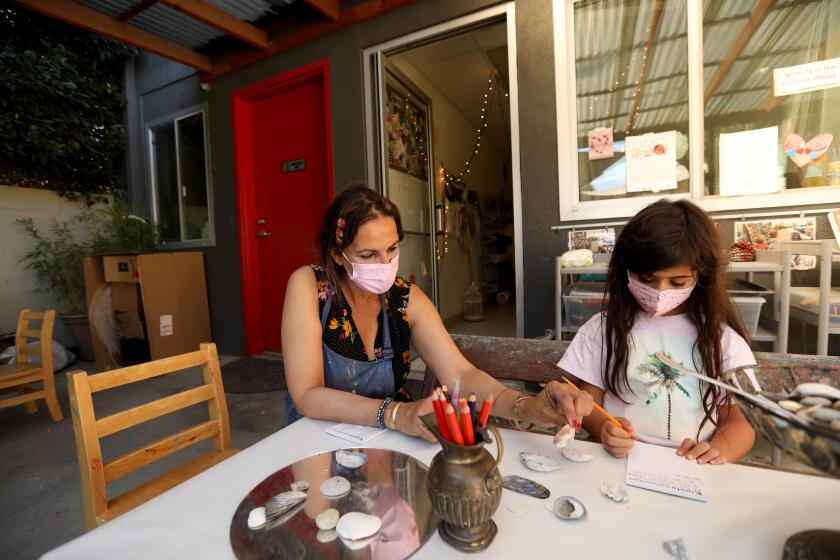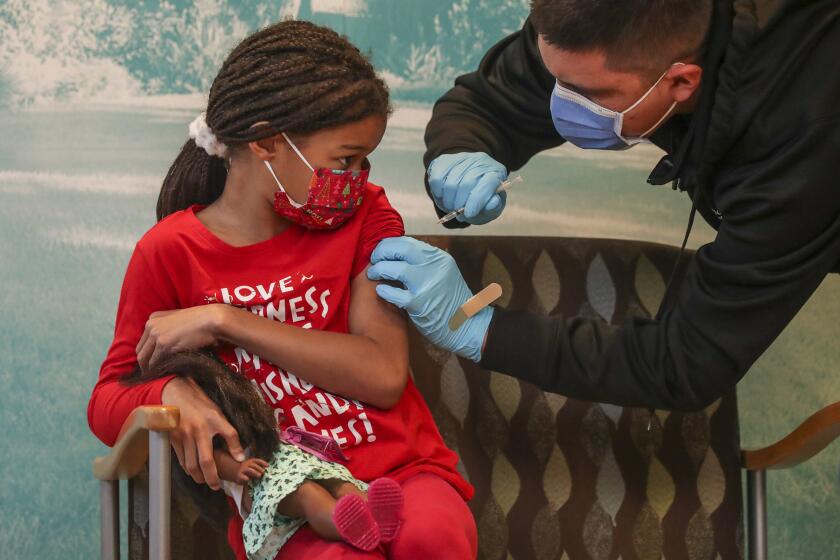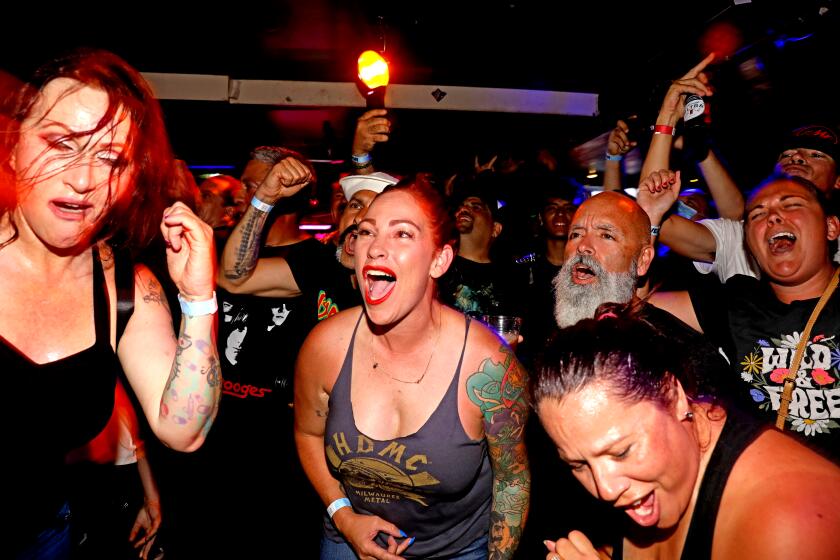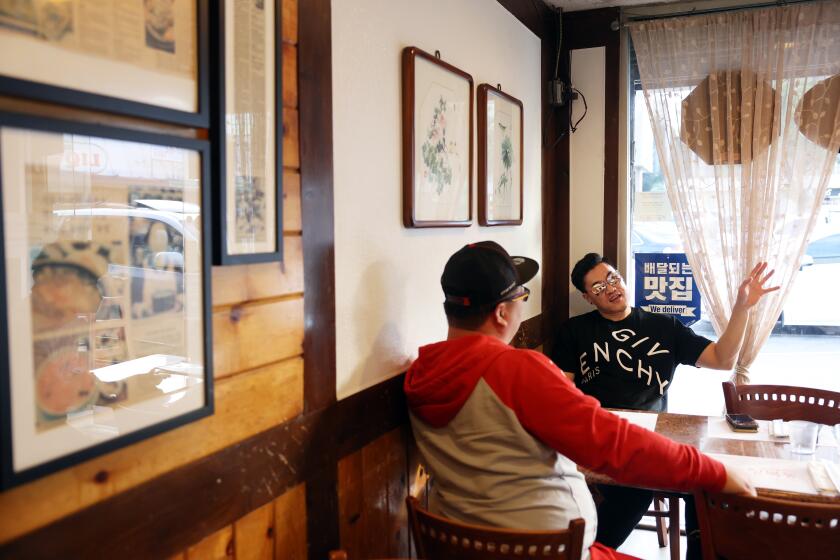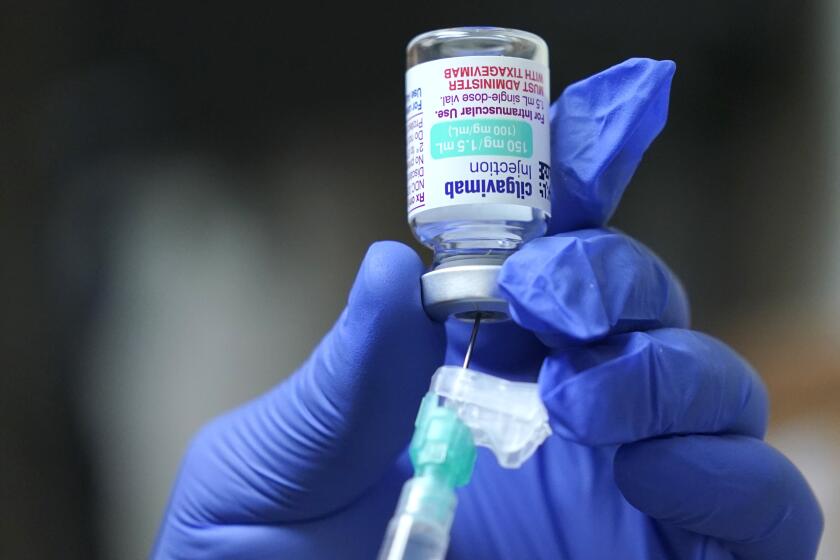Maskless at gym? At grocery? Dining indoors? Experts break down risks as COVID cases fall

- Share via
It’s been more than three weeks since California eased its requirement that residents mask up in most indoor public areas, but not everyone has been quick to change their own daily habits.
Whether they’re still cautious about the state of the pandemic or simply acknowledge the continued protection masking provides, some doctors and public health experts are continuing to take precautions that go above and beyond the minimum mandates outlined at the state and local levels.
Here’s what they are saying:
‘For the foreseeable future, I’ll wear my mask’
Dr. Mark Ghaly, California’s health and human services secretary, said he still wears a mask while at the grocery store — something the state strongly recommends but no longer requires.
“I don’t know how long I will. I hope there comes a point where ... following the data, I’m going to do something different down the road. But for the foreseeable future, I’ll wear my mask,” he said during a conversation recently hosted by the Sacramento Press Club.
Indoor dining at a restaurant also remains off the table for now, he said.
Health officials still recommend masks in indoor public settings, but school operators will be able to require masks or make them optional.
Ghaly lives in L.A. County, where the case rate was 73 weekly coronavirus cases for every 100,000 residents, according to The Times’ coronavirus tracker as of late Saturday, which puts the county in a category of substantial transmission. San Francisco is recording 28 cases for every 100,000 residents, putting the city in moderate transmission.
Shopping, dining
Dr. Robert Wachter, chair of UC San Francisco’s Department of Medicine, said case rates have declined enough that he resumed dining at indoor restaurants in late February. On the other hand, when he’s at a supermarket, he’s not bothered by wearing a mask.
“I see no reason to put myself at any risk while shopping, and I see some reason to go out to dinner,” he said during an interview.
Masks at the gym?
Dr. Peter Chin-Hong, an infectious-disease expert at UC San Francisco, has made the same decisions.
At the gym, Chin-Hong stopped wearing a mask as soon as San Francisco eased its order in late January for gyms and offices.
Chin-Hong’s gym still requires members to be vaccinated, and there’s a lot of ventilation, with high ceilings.
“So I feel comfortable in all activities in the gym — well, except maybe spin class, which I wouldn’t do normally anyway,” he said. “But treadmill? Yes. Free weights? Yes.”
If he were to go to a crowded indoor spin class, Chin-Hong said he’d probably wear a mask until there’s less likelihood of the coronavirus circulating. His barometer of safer conditions would be comparing the case rates to around June 15, when the state fully reopened and he “felt comfortable actually going out without a mask everywhere.”
California has been reporting 71 cases a week for every 100,000 residents; on June 15, the state was reporting 17 cases a week for every 100,000 residents.
Dr. Abraar Karan, an infectious-disease expert at Stanford University, said he continues to wear a mask at the gym and other indoor public spaces.
“Part of this is to allow cases to get even lower; partly to show support and support those who are immunocompromised,” Karan said.
Safety in the numbers
Another indicator of safer conditions would be when a county’s case rate falls below 50 a week for every 100,000 residents, Chin-Hong said. According to The Times’ coronavirus tracker as of Saturday afternoon, the rate for San Diego County is 112; San Bernardino County, 76; Los Angeles County, 73; Riverside County, 53; Santa Barbara and Ventura counties, 42; ; and Orange County, 31.
In the Central Valley, the rate in Sacramento County was 72; in Fresno County, it was 93; and in Kern County, it was 63.
Data show vaccines are effective against hospitalizations, although effectiveness against infection does wane. But that’s not surprising.
Chin-Hong said he’s worried about people who seem to be sheltering in place indefinitely. He thinks they can go out now, maybe “up their mask game in crowded indoor settings, but it’s relatively not that risky to them in low-risk settings now.”
If you aren’t comfortable dining inside, it is a bit easier in Southern California to stay comfortable outdoors, where the risk of viral transmission is significantly reduced. Dr. Regina Chinsio-Kwong, the Orange County health officer, said other ways to reduce risk include dining at restaurants that still practice distancing measures, limiting time at a restaurant and wearing masks when not eating.
But everyone will have to make their own decisions. Many gyms in California don’t require proof of vaccination. Although the city of Los Angeles currently requires indoor gym customers to show proof of vaccination, the City Council took the first step Wednesday toward lifting vaccine verification requirements at restaurants, gyms and other venues.
L.A. County has relaxed its protocols around masking and vaccinations for most concerts, but individual cities, venues and artists can set their own rules.
“If you are a young person who’s healthy, who’s been vaccinated, who’s been boosted, and who is not around others that may be vulnerable, you’d feel much more comfortable going into places without masks,” Dr. Robert Kim-Farley, a UCLA epidemiologist and infectious-disease expert, said in an interview.
“Someone who is elderly, someone who has multiple medical conditions, someone who is immune-compromised — where they’re at higher risk of coming down with severe disease — would rightly wish to consider using masking and the protection it gives when they enter into crowded indoor spaces,” Kim-Farley said.
Some people may also want to wear a mask to prevent the risk of bringing home the virus to a vulnerable family member, who might get severely ill or die from COVID-19.
Living with the immunocompromised
One of them is Dr. Clayton Chau, director of the Orange County Health Care Agency, who lives with his immunocompromised mother, who is in her 80s. He said he wears a mask both inside stores and in crowded outdoor areas. “I’m extra careful because I have somebody who is at high risk that I live with,” Chau said in a broadcast Tuesday night.
Los Angeles moves to lift vaccination verification requirement at restaurants, bars, hair salons, gyms and movie theaters.
“We need to make sure we don’t stigmatize people wearing masks. People should have that right to wear masks or not when there’s no mandate,” Kim-Farley said.
That personal assessment is especially key for immunocompromised residents who don’t enjoy the same level of vaccine protection as others.
But officials say people with weakened immune systems now have many more strategies than just staying at home. Immunocompromised individuals are eligible for a fourth COVID-19 vaccination dose and should be aware of Evusheld, an injectable antibody drug that offers long-term prevention of COVID-19.
Evusheld can help protect immunocompromised people from COVID, but patients say scant awareness and a complicated process have hampered its rollout.
Gatherings can be safer if attendees take rapid tests right beforehand. The U.S. government on Monday allowed every household in the nation to order an additional free set of four rapid at-home coronavirus tests; many ordered their households’ first free tests in late January. They can be ordered at covidtests.gov or by calling (800) 232-0233.
People with health insurance also can order at-home tests and seek reimbursement through their health provider. Federal officials require insurance companies to cover the cost of eight over-the-counter at-home tests for every insured person per month, meaning a family of four can get 32 tests every month for free.
Times staff writer Emily Alpert Reyes contributed to this report.
More to Read
Sign up for Essential California
The most important California stories and recommendations in your inbox every morning.
You may occasionally receive promotional content from the Los Angeles Times.
